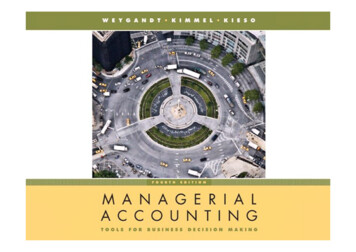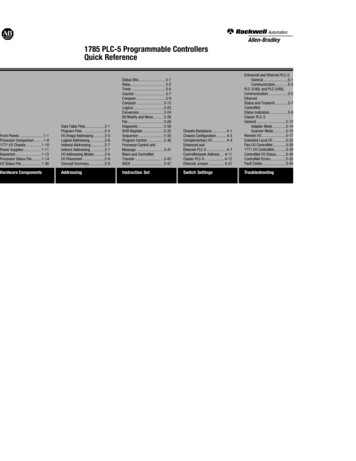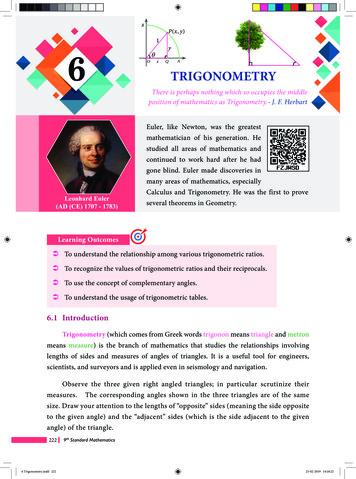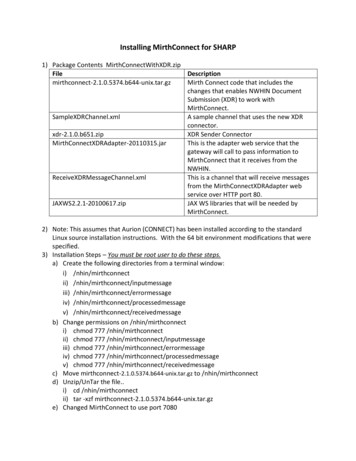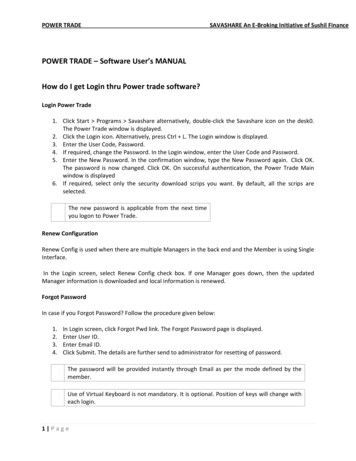
Transcription
Horizontal Side-Channel Vulnerabilities ofPost-Quantum Key Exchange ProtocolsAydin Aysu, Youssef Tobah, Mohit Tiwari, Andreas Gerstlauer, and Michael OrshanskyDepartment of Electrical and Computer EngineeringThe University of Texas at Austin, Austin, TX, eduAbstract—Key exchange protocols establish a secret key to confidentially communicate digital information over public channels.Lattice-based key exchange protocols are a promising alternativefor next-generation applications due to their quantum-cryptanalysisresistance and implementation efficiency. While these constructionsrely on the theory of quantum-resistant lattice problems, theirpractical implementations have shown vulnerability against sidechannel attacks in the context of public-key encryption or digitalsignatures. Applying such attacks on key exchange protocols is,however, much more challenging because the secret key changesafter each execution of the protocol, limiting the side-channeladversary to a single measurement.In this paper, we demonstrate the first successful power sidechannel attack on lattice-based key exchange protocols. The attacktargets the hardware implementation of matrix and polynomialmultiplication used in these protocols. The crux of our idea isto apply a horizontal attack that makes hypothesis on severalintermediate values within a single execution all relating to the samesecret and to combine their correlations for accurately estimatingthe secret key. We illustrate that the design of key exchange protocolscombined with the nature of lattice arithmetic enables our attack.Since a straightforward attack suffers from false positives, wedemonstrate a novel procedure to recover the key by following thesequence of intermediate updates during multiplication.We analyzed two key exchange protocols, NewHope (USENIX’16)and Frodo (CCS’16), and show that their implementations can bevulnerable to our attack. We test the effectiveness of the proposedattack using concrete parameters of these protocols on a physicalplatform with real measurements. On a SAKURA-G FPGA Board,we show that the proposed attack can estimate the entire secret keyfrom a single power measurement with over 99% success rate.I. I NTRODUCTIONKey exchange protocols enable agreement on a secret keybetween two parties. Traditional key exchange protocols suchas Diffie-Hellman rely on the difficulty of solving the discretelogarithm problem over various groups, which are widely regarded to be infeasible for large numbers. These problems,however, can be solved in polynomial-time with quantum algorithms [1, 2], generating a significant interest in alternative keyexchange protocols that will future-proof security systems [3–5] in case of a breakthrough in quantum computing technology.Lattice-based cryptography provides a wide array of such constructions that are resistant to quantum attacks. Among latticesolutions, proposals relying on Learning-With-Errors (LWE) [6]and Ring-Learning-With-Errors (R-LWE) [7] are especially favored due to their implementation efficiency [8, 9].While these constructions rely on the theory of quantumresistant lattice problems, their practical implementations haveshown vulnerability against power side-channel attacks in thecontext of public-key encryption or digital signatures [10–20].These attacks find the secret key by exploiting the reflection ofkey-dependent computations on dynamic power consumption. Toextract this dependence, prior attacks on lattice problems userepeated computations performed with the same secret key.Fig. 1. Vertical DPA (a) targets a single intermediate computation and seekscorrelation across multiple traces each using a distinct input, while HorizontalDPA (b) targets multiple intermediate computations within a trace and seeks acorrelation among them.To that end, differential power analysis (DPA)[21] is a powerful side-channel attack that works with a divide-and-conquerprinciple: It makes an estimation on distinct parts of the key(called sub-key) and checks those estimations through multipletests. These tests are required to remove the noise and reveal theunderlying correlation between the sub-key and the power measurement. Once the target sub-key is derived, the adversary canattack the next sub-key by using the same set of measurements.Applying DPA is, however, signficantly more challenging on keyexchange protocols because these protocols, unlike public-keydecryption or digital signatures, work with ephemeral secrets:each invocation of the protocol will process a unique value thatwill result in a new, distinct secret key. Therefore, the adversaryis limited to a single power measurement.Figure 1(a) illustrates the classic DPA, known as Vertical DPA.In this attack, the adversary performs a single test on the powertrace and collects multiple measurements (each with a differentinput) to extract sub-key correlations from noise. The intermediate computations on the variable var1 is selected as the targetbecause its value depends on the public input and a sub-key.Horizontal DPA [22], Figure 1(b), by contrast, performs multipletests by targeting different computations and combines them toextract the sub-key from a single power measurement. HorizontalDPA thus focuses on intermediate computations that use variablesvari (i 1, 2, ., n) that all depend on the public input andthe same sub-key. The main challenge of applying HorizontalDPA is in finding multiple tests to be performed within a singlecomputation that will leak the same sub-key. Such approacheshave been successfully applied to modular exponentiation [22]and elliptic curve multiplication [23], but lattice arithmetic isbased on fundamentally different computations for which nosuccessful horizontal side-channel attack has been shown so far.In this paper, we demonstrate, for the first time, that latticearithmetic used in key exchange protocols is vulnerable toHorizontal DPA attacks. Specifically, we demonstrate that the
matrix and polynomial multiplication used in these protocolshave a large number of intermediate computations that depend onthe same sub-key. A straightforward attack on these operations,however, causes false positives because similar sub-keys willproduce similar multiplication output (e.g. sub-keys of ‘1’ and‘2’ will generate the same values shifted by one binary digit).We show that an adversary can address this limitation and stillsucceed by using a novel attack that targets intermediate stateupdates of these multiplications starting from the first sub-key tosuccessively recover a chain of subsequent sub-keys. This attackeffectively removes false positives after the first sub-key.We analyze the feasibility of the proposed attack on twostate-of-the-art key exchange protocols: Frodo [24] and NewHope [25]. While Frodo performs matrix multiplication, NewHope uses polynomial multiplication. Both protocols performmultiplications between a secret ephemeral value and a publicinput, making them susceptible to the proposed Horizontal DPAattack. Once the ephemeral secret is discovered with the proposedattack, we show that an adversary can recover the exchangedsecret key in these protocols. Moreover, we show that both partiesengaged in the protocol are vulnerable to our attack.To test the practical validity of our attacks, we design thematrix and polynomial multiplication in hardware using thespecific parameter sets of the two protocols, and we apply theattack using real power measurements taken from a SAKURA-GFPGA platform. We validate that the number of horizontal tests,which is 1024 for NewHope and 752 for Frodo, is sufficientto extract the key. The results show that the proposed attack isable to recover secret keys with over 99% probability.The rest of the paper is organized as follows. Section IIdescribes the threat model of DPA. Section III provides a background on power side-channels and discusses the related work.Section IV analyzes the protocols under attack and gives a highlevel description of the proposed attack. Section V shows the details of hardware architectures used in analysis and evaluates theattack efficiency with real measurements. Section VI discussesthe limitations and countermeasures of our attack. Section VIIconcludes the paper.II. T HREAT M ODELOur threat model follows the typical power side-channel modelof prior work [10–21]. The adversary in DPA attacks has physicalaccess to the device and can read power measurements asthe device computes the cryptographic routine. Therefore, theadversary is equipped with a reasonable measurement setupthat can obtain power consumption information several timeswithin a clock period. In our experimental setup, which targets adevice operating in the MHz frequency range, a low-end digitaloscilloscope with passive probes is sufficient to apply the attack.We assume that the attacker in our model can record a singlepower measurement of the entire application (e.g. HTTPS/TLS)that uses the key exchange protocol. We also assume that theDPA adversary knows details of hardware architecture, such asits data flow, parallelization and pipelining. Therefore, unlessthere is a specific countermeasure to obfuscate the timing of theunderlying operations, the adversary can estimate when the targeted computations will likely occur and apply the attack aroundthose clock cycles. Engineering aspects of locating cryptographicroutines (and specific operations inside those routines) amongother applications within a system has been described in priorwork, both in the context of physical [26] and digital sidechannels [27, 28]. We do not cover this aspect in the scope ofthis work and assume that the adversary can locate around whichclock cycle to start the DPA analysis using prior techniques.Note that the adversary does not have to know the exact timinginformation of side-channel leaks within the clock period; it canexhaustively evaluate the attack on all sampling points within aperiod to identify where the side-channel leak occurs.We follow the assumption that the DPA adversary can eavesdrop on the communication to record the public messages that areexchanged between two parties. We conduct the DPA attack ona hardware implementation with a fixed execution time and withno conditional checks based on the value of sub-keys. Therefore,unlike software implementations of the same protocols, theattacker cannot use timing side-channels or information leaksof conditional branches in the analysis.III. BACKGROUND AND R ELATED W ORKAlthough power-based side-channel attacks have been an active area of research for the last two decades [21], analysis oflattice-based constructions is relatively limited [10–20]. Theseattacks consider other applications with lattices such as publickey decryption or digital signatures. None of the existing proposals are applicable to our problem where the attacker has toextract the entire key from a single power measurement on ahardware implementation that has no conditional branch leaks orlarge power variations (exploitable e.g. SPA attacks) based onsecret key values. Therefore, to our best knowledge, our work isthe first power-based attack on a hardware designed for latticebased key exchange protocols.We can broadly categorize power side-channel attacks intothree groups: simple power analysis (SPA), DPA, and templateattacks. SPA is based on purely visual observations to capturelarge variations related to secret key with a few traces. Bycontrast, DPA extracts small correlations by evaluating manytraces with statistical methods. We refer to attacks that requirea pre-characterization of the device as template attacks [29].In our classification, we consider attacks using electromagneticradiation synonymous to power-based attacks as they use thesame principles, and we therefore review EM attacks in ourrelated work. In the following, we evaluate the prior work onlattice-based side-channels in detail and discuss why we need anew approach to attack key exchange protocols in hardware.SPA Attacks: Park et al. proposed an SPA attack on the polynomial mulitplication of the R-LWE-based public-key decryptionprocess, exploiting the SPA power leaks of an implementationon 8-bit AVR microcontrollers. This attack does not succeedin our scenario for two reasons. First, we design a hardwarewithout this vulnerability and second, the attack requires multiplemeasurements of the same decryption key to extract the full key.DPA Attacks: Several DPA attacks have been proposed onthe multiplications of lattice-based public-key decryption [11–17]. However, all of these attacks are instances of Vertical DPA,focusing on one intermediate variable within the power traceand extracting the key using many power traces. Therefore, theirattack procedure cannot be used in our setting.Template Attacks: Primas et al. recently proposed a singletrace template attack on the Number Theoretic Transform (NTT)based polynomial multiplication of an R-LWE decryption procedure [18]. This attack, similar to the majority of template attacks,
Parameters: q 215 , A Zn n, n 752, m̄ n̄ 8qError distribution: χ D3 ( 5, ς 2 1.75)Aliceseed {0, 1}128A Gen(seed)Bob S0 , E0 χ(Zqm n ) nE00 χ(Zm)q(B,seed) 0Bob s0 ,e0 , e00 ψ n16(b,seed)A Gen(seed)B0 S0 A E0V S0 B E00C hVi2B(B ,C)K Rec(B0 S, C)Aliceseed {0,1}256a Gen(seed) s,e ψ n16b as e S, E χ(Zn n)qB AS EParameters: q 12289 214 , n 1024Error distribution: ψ16K bVe2B(a) (b0 ,r)00v b sv Rec(v0 , r)k SHA3-256(v) a Gen(seed))b0 as0 e0v bs0 e00 r HelpRec(v)v Rec(v, r)k SHA3-256(v)(b)Fig. 2. Frodo (a) and NewHope (b) key exchange protocol and the parameters we select for their instantiations. We highlight the target of DPA attack; in bothprotocols, the ephemeral secrets (S, S0 or s, s0 ) are multiplied with a public value (A or a).requires a precise power-behavior characterization of the targetdevice. Therefore, it assumes that the adversary can configurethe target device for each possible sub-key guess and collect alarge set (consisting of 100 million samples) of traces to buildtemplates. These templates are later matched for a given powertrace and secret key is estimated with a maximum likelihoodtest. This attack is proposed on a software implementation of RLWE decryption and it exploits several ARM ISA specific vulnerabilities, including a timing side-channel of modular divisioninstructions. Our attack, on the one hand, complements their analysis since we target matrix multiplication and regular polynomialmultiplication, and since we analyze hardware implementationsthat have no timing side-channels. On the other hand, our attackenables a simpler, more practical recovery of secret keys viaDPA, which does not require costly pre-characterization or theability to configure the target device with different keys. Pessl etal. demonstrated a template attack on a software implementationof lattice signature scheme [19]. This attack estimates the controlflow (i.e. data dependent branch operations) and intermediatevariables of lattice sampling. Then, using multiple measurementsand associated signatures, it extracts the secret key with latticereduction techniques. The requirement of multiple measurementsagain makes this attack infeasible in our scenario.Combined Attacks: Espitau et al. shows two power sidechannel on a software implementation of a lattice signaturescheme [20]. The first one is an SPA attack on an 8-bit AVRmicrocontroller. The attack targets the conditional branching ofrejection sampling and combines several measurements to extractthe key. This attack is not possible in our scenario since it requiresmultiple measurements and since we are interested in hardwarewithout conditional branch leaks. The second attack focuses onthe sparse polynomial multiplication that is implemented as asequence of repeated shifted additions. Their attack first estimatesthe indexes of non-zero elements by applying an SPA on theconditional branches, and then performs a DPA attack on thoseto reveal their sign. Using this information, the attacker applies anInteger Linear Programming to extract the actual values of thosecoefficients. This attack is not possible in our scenario becauseour target protocols use matrix and non-sparse multiplicationsand because we are interested in hardware without conditionalbranch leaks.In summary, template attacks using conditional branch leaksor timing side-channels and SPA are not applicable on properhardware-only solutions. Template attacks also require a precharacterization of the device that is not possible in every threatmodel. Therefore, DPA is a suitable and effective technique but itcan only work in our scenario if the adversary can find multipletests within a single trace. This analysis leads us to applying aHorizontal DPA attack.IV. H ORIZONTAL S IDE - CHANNEL A NALYSIS OFP OST-Q UANTUM K EY E XCHANGE P ROTOCOLSIn this section, we first summarize the key exchange protocolsthat we attack, and we highlight the target operation of ourHorizontal DPA. Then, we give a high-level description of ourattack and how to address its challenges.A. Post-quantum Key Exchange ProtocolsKey exchange protocols establish a unique, symmetric keybetween two parties. Both parties in these protocols use anephemeral secret to generate some public information and shareit with the other party to successfully agree on the same key.The protocol is designed in such a way that the adversarywho eavesdrops on the public information cannot capture theestablished key or recover the ephemeral secret values.Figure 2 gives the description of Frodo (a) and NewHope (b),respectively. The main difference between the two is that whileFrodo relies on the LWE problem1 , NewHope uses R-LWE.Therefore, while Frodo works with matrices (denoted withcapital Latin letters), NewHope processes polynomials (denotedwith lowercase Latin letters).In both protocols, Alice starts by generating a public parameter(A, a) from a random seed, sampling the secret error terms (Sand E, s and e) from a specific distribtuion, and computingthe message (B, b), which is sent, together with the seed toBob. Given B and A, it should not be feasible, either with aconventional or a quantum computer, to compute the values ofsmall error terms S and E due to the LWE problem [6] (the1 Frodo deliberately picks LWE over R-LWE in case there is a future reductionin the assumed difficulty of underlying R-LWE problems.
Fig. 3. An example of Horizontal DPA attack on the polynomial multiplication; same concepts also holds for matrix multiplicationanalogous holds for NewHope polynomials a, b, s, and e withthe R-LWE problem [7]). Bob then generates his share of thesecret key (B0 , b0 ) by using his ephemeral error samples (S0 andE0 , s0 and e0 ) and sends it to Alice. Alice and Bob now can agreeon the secret value by evaluating each others’ terms with theirephemeral secrets. Since Alice and Bob will achieve a similarbut noisy term, they can reconcile by recovering from this noisethrough a thresholding scheme. Interested readers can refer to[25] and [24] for details of these protocols.Frodo has several parameter options depending on the desiredsecurity level. For our analysis, the parameters for the Frodoare selected from the “Recommended” scheme. This set usesmatrices of sizes n n, n n̄, m̄ n̄, and m̄ n̄, where n, n̄, andm̄ are, respectively, 752, 8, and 8 with integer elements modulo215 . The error distribution is a Rényi divergence approximationto a rounded continuous Gaussian with variance ς 2 1.75, whichis centered at 0 with a tail cut at 5. NewHope has a fixedparameter set that operates in the ring Rq Zq [x]/hxn 1i, whichuses polynomials of degree 1023 with integer coefficients modulo12289 and a binomial distribution for small (error) polynomialswith integers coefficients from -16 to 16, centered at 0.B. Protocol Operations Under AttackFigure 2 highlights the possible points of attacks for ourHorizontal DPA. We focus on the multiplication of public valueA (resp. a) with the ephemeral secret S or S0 (resp. s or s0 )in Frodo (resp. NewHope) protocols. The target operation forFrodo is therefore a matrix multiplication of the public valueA with the ephemeral secret S or S0 . This is multiplication of asize 752 752 matrix with a size 752 8 or 8 752 matrix.For the case of NewHope, the DPA target is the multiplicationof two polynomials with degree 1023.Note that both Alice and Bob can be attacked using thisapproach. Once the adversary recovers the ephemeral secret,extracting the exchanged secret key becomes trivial. For Frodo,an adversary attacking Alice can compute K Rec(B0 S,C)and an adversary attacking Bob can first recover V (withoutthe small error of E00 ), and then generate K bVe2B sincebVe2B bV E00 e2B . The same principle also holds for theNewHope protocol. Once the adversary captures the polynomials or s0 , it can recover the secret key k.C. The Crux of Horizontal DPA on MultiplicationFigure 3 illustrates the main idea behind our Horizontal DPAattack on a polynomial multiplication; the same principle appliesto matrix multiplication as well. For simplicity, this exampleuses a polynomial of degree 3 and with coefficients modulo 28 .The figure reflects the schoolbook polynomial multiplication of apublic polynomial (e.g. a) with an ephemeral secret polynomial(e.g. s). The polynomial multiplication has two main parts:1) Generating Partial Products: Each row of multiplicationin Figure 3 corresponds to the product of a single secretcoefficient of s with all coefficients of public polynomiala; we refer to this method as row-wise multiplication. Thein-place reduction is simply a sign change (modulo 28 ) ofthe reduced coefficient (depicted with the dashed boxes inFigure 3) for the partial products having degree greater than3. This degree reduction occurs since the lattice arithmeticis in Rq Zq [x]/hxn 1i, where the reduction functionf (x) is xn 1.2) Updating Intermediate Sum: The result of polynomialmultiplication is the addition of all row-wise computationsmodulo 28 . Therefore, after a partial product is computed,its value has to be accumulated into and a modular reduction be applied on the intermediate sum that holds the resultof previous row computations. After all rows are processed,the value of the intermediate sum will be the result of thisoperation.Figure 3 highlights, in bold red, the first row of computationsand its dependence on the first secret coefficient. The crux ofour attack is to observe that all of these operations rely on thesame coefficient of the secret polynomial. The same concept isalso true for the matrix multiplication of Frodo. The adversary,therefore, can effectively apply a Horizontal DPA using theseoperations: it can make a hypothesis guess on a secret coefficient,compute the hypothesis value for each intermediate computation,and test correlations between those values and correspondingactivity within the single power trace.The main problem of applying DPA on the target latticebased constructions is the false positives of multiplication. Unlikethe case of AES or other block ciphers where an S-BOXmaximally diffuses similar inputs, multiplications with similarvalues generate a correlated output. For example, if a secretcoefficient is ‘1’ vs. ‘2’, the output of the multiplication willbe shifted by one binary digit, resulting in an output having thesame Hamming weight unless there is a modular reduction. Evenwhen there is a modular reduction, the output changes by a singleoverflow bit if the modulo value is a power of two, which isexactly the case for the modulo 215 multiplication of Frodo.
Fig. 4. Hardware architecture of operations under attack for Frodo (a), NewHope (b), and NewHope (c)The solution to this problem is to target the intermediate sumupdate and to extract one key bit at a time, successively, startingfrom the first coefficient of the key. Since the intermediatesum for every coefficient is ‘0’ in the first row, attacking thesesums will be equivalent to attacking partial product generation,hence resulting in false positives. However, due to the modularreductions, after the first row, there is a single guess that yieldsa high correlation for all previous distinct guess. Therefore,our attack will form an ensemble of possible keys, rather thanforming a tree having multiple independent false positives at eachrow of computations.The number of possible horizontal tests depends on the degreeof the polynomial. Since NewHope works with degree 1023polynomials, our attack can perform 1024 tests for each keyguess. For the Frodo protocol we can conduct 752 tests.Note that our attack does not require enforcing specific patternsin the input (e.g. Fouque et al. [30]) to estimate the secret key. Anadversary using our attack, therefore, does not have to invoke ormodify an encryption request. Instead, it can simply eavesdrop onthe communication (in addition to recording power consumption)to extract the secret key, which is less likely to be detected froma higher-level detector in the system.Another important feature of our attack is the implicationof using larger keys to improve theoretical security. In bothprotocols, a future update on the parameter set, which typicallyoccurs due to disclosure of better attacks, can increase thepolynomial size of the key—this improves the effectiveness ofour attack as it increases the number of test for the horizontalanalysis.V. E VALUATING THE H ORIZONTAL ATTACKSIn this section, we evaluate the effectiveness of our proposedHorizontal DPA attack on our FPGA-based hardware implementations using real power measurements.A. Hardware ArchitectureWe primarily focus on resource-constrained applications inembedded devices, such as RFID, smart cards or IoT nodes.As such, we design and analyze coefficient-serial architecturesthat compute a single coefficient of multiplication in a clockcycle. This design uses one multiplier as its main processingunit. Therefore, it takes approximately m̄ n n clock cyclesto compute a matrix multiplication of A·S and n n cycles tocompute the polynomial multiplication of a·s.Figure 4 (a), (b), and (c) respectively show the details of thehardware architecture for Frodo, NewHope , and NewHope,where NewHope is a simplified instantiation of NewHopearithmetic to evaluate the impact of modular reduction on ourDPA attack. The main processing unit of Frodo and NewHope is a multiplier to compute the partial products. The result of thepartial product is accumulated to the previous value stored inintermediate memory, which updates the intermediate sum. Sincethese two instantiations use a modular reduction with a power oftwo, the modulo operation is free, which is simply a truncationof the adder output to log2 q bits.However, in the NewHope case, the modular reduction is withthe constant integer 12289. Thus, NewHope requires a fullscale reduction after the modular multiplication. To efficientlyimplement this operation, we used the Barret Reduction technique [31], which computes the modular reduction with twomultiplications and a small number of subtractions. Listing 1shows the pseudo-code. This method essentially estimates thequotient of the modular division and removes the misprediction,which has a fixed range, by a sequence of subtractions and boundchecking. The range, for the case of 12289, is between 0 and12289 3. We also integrate the final addition of the intermediatememory updates with this operation and we check the boundsbetween 0 and 12289 4. To ensure a constant-time operationand minimize power side-channel leakage, we perform this boundcheck in parallel and find the result (based on the overflow bitsof subtraction) in one clock cycle.The size of matrix A, which requires storing 752 752 15bits, creates a problem for the Frodo implementation. Sinceour target FPGA cannot store this amount of data due to BRAMlimitations, it has to generate parts of A on-the-fly during thecomputation of A·S. To do so, our architecture follows theguidelines of [24], and generates one column of A at a timeand multiplies it with one row of S to compute the partial resultsfor the entire A·S matrix. Only then, does the hardware generatethe next column of A and repeat the same process until all thecolumns of A are swept. This approach minimizes the required
Algorithm 1 Barret reduction of positive integers with a fixedmodulus [31]1: procedure BARRET R EDUCE(x, m, µ, r)input: x (x2k 1 · · · x1 x0 ) 2 , m (mk 1 · · · m1 m0 )2 (withmk 1 1), µ 22k /moutput: r x mod m 2:q1 x/2k 13:q2 q 1 · µ 4:q3 q2 /2k 15:rt x m · q36:while rt m do7:rt rt m8:end while9:r rt10: end procedureamount of storage for A.All these architectures use a generic modulo q sign conversionon secret key (S, s) coefficients to handle the sign arithmetic andin-place conversions; a similar approach is also taken by priorwork on an area-optimized lattice-hardware design [32]. Thereare two reasons for this approach. First, it allows to mitigatezero-value attacks on lattice arithmetic ([11], Appendix A) whena secret coefficient is equal to 0, and second, it enables achievinga modular design, independent of the size of s coefficients. Sincethe multiplication and additions are mapped to a DSP unit, whichcan compute up to a 18-bit multiplication and 48-bit addition,converting s (or S) coefficients into log2 q bits does not carry anarea overhead.The hardware architectures we propose are implemented inVerilog HDL and mapped on to the Xilinx Spartan-6 XC6SLX75FPGA. The synthesis, placement, and routing of the proposeddesigns to the target FPGA is performed using Xilinx IntegratedSynthesis Environment (ISE) version 14.6.B. Evaluation SetupTo evaluate the power attacks in a real environment, we portedour implementations on the SAKURA-G board, which includes aXilinx Spartan-6 (XC6SLX75-2CSG484C) FPGA. We measurethe voltage drop on a 1-Ω
large power variations (exploitable e.g. SPA attacks) based on secret key values. Therefore, to our best knowledge, our work is the first power-based attack on a hardware designed for lattice-based key exchange protocols. We can broadly categorize power side-channel attacks into three groups: simple power analysis (SPA), DPA, and template attacks.

